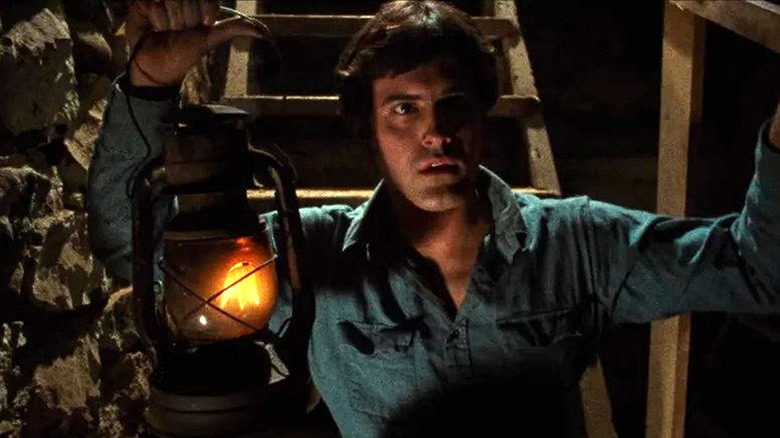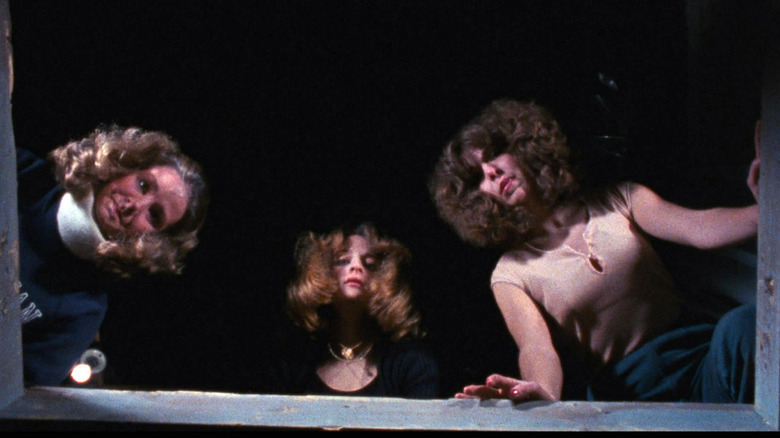Limitations Defined Sam Raimi's Shooting Style On Evil Dead
In a Rolling Stone interview for "Doctor Strange in the Multiverse of Madness," Brian Hiatt asked director Sam Raimi about the expectations to build a fantastic spectacle for each new Marvel release. There's something special that makes each Sam Raimi movie a Sam Raimi movie, but his visual idiosyncrasy does not fit the cookie-cutter style of the Marvel machine. Before its release, audiences wondered how much Raimi would actually be felt in the new "Doctor Strange."
"No one moves the camera like you," Hiatt told Raimi in the interview. The filmmaker recalled how his tiny budget on "The Evil Dead" — the complete opposite of the gargantuan CGI Marvel property — pushed him to create imaginative scares.
"It came from limitations and trying to solve them. With 'Evil Dead,' we couldn't build the monster — so we had to just use its point of view. And we tried to add as much strangeness to that point of view as possible because the audience would use whatever was given them there to build their own monster in their head. So we put a big, wide lens on the camera to make it distorted around the edges. We put it on a stick that we could raise up and lower down over objects — it was literally flying. Other times I would tape it to my hand and wave my arm up and down as I was running, trying to keep it as smooth and eerie as possible. I guess we learned our most important filmmaking lesson, which is that the audience can always create something in their mind more effectively than we can show them."
These kinds of limitations often benefit filmmakers, particularly in the horror genre. The most notable example of this, of course, is the malfunctioning shark in "Jaws," which forced Steven Spielberg to hold the major reveal until the end of the film.
The Deadites are watching
Raimi's offbeat shots in "The Evil Dead" established him as a filmmaker with a singular style. Since he didn't have the funds for fancy equipment, he had to make eccentric visual choices to convey the Deadites' power. His camera assumes the role of the supernatural force stalking the five friends with manic glee as it dives over bodies of water and in between trees. These images feel like a deranged ballet, wildly gliding through the spooky forest to evoke feelings of fear, confusion, and being cornered by evil monsters.
The use of different angles is another distinctive feature of "The Evil Dead." He would often position his camera at odd angles, observing the characters from a distance, through windows, or putting specific objects in the foreground. For example, Raimi focuses on a porch swing that stops moving as soon as the friends enter the cabin. By placing the eerie porch swing in front of the camera and the five friends far away and off to the side, Raimi suggests something mysterious is controlling the cabin and its new inhabitants are mere pawns.
The use of low angles creates a claustrophobic and ominous feeling, signaling the horror that unfolds. It also allows the limited space of the cabin to seem more dynamic. Raimi's frequent use of Dutch angles, especially in conjunction with tight close-ups of the frightened characters, frames their world as off-kilter and uncontrollable after being invaded by the deadly demons.
While this type of visual style made "The Evil Dead" scarier, it also fits the Looney Tunes aesthetic of "Evil Dead II" and "Army of Darkness." In those films, the flying camera became less of a malevolent force and more of an unhinged accessory to the cartoonish lunacy on display.

